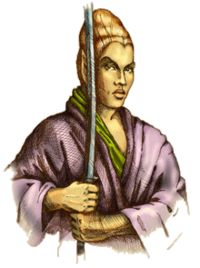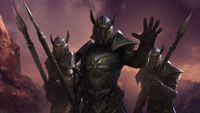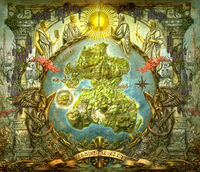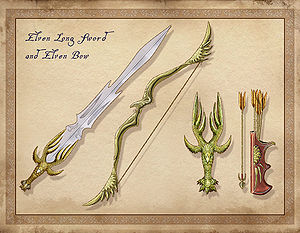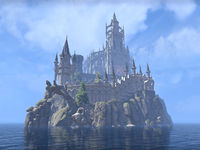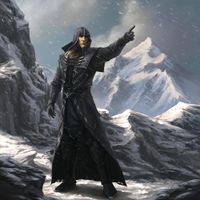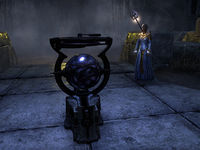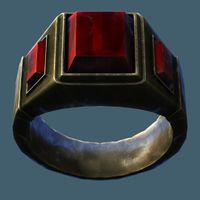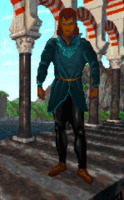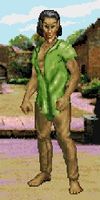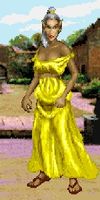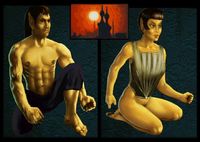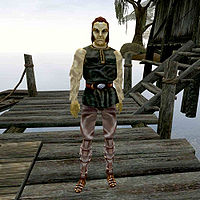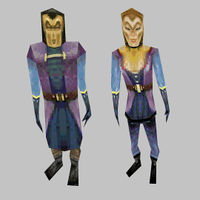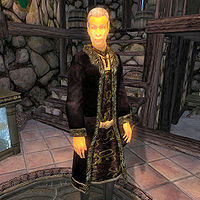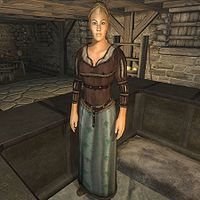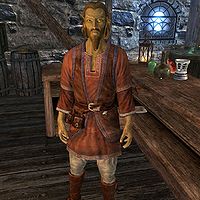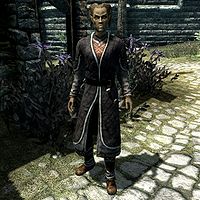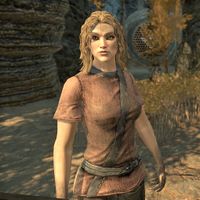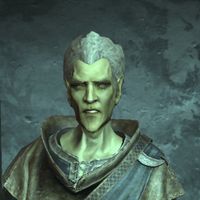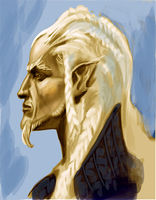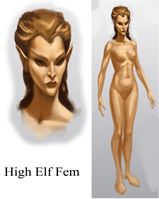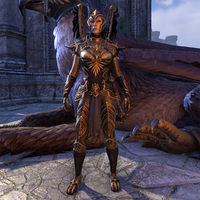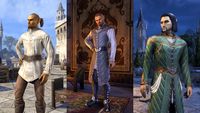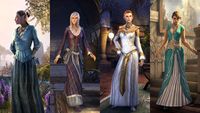Lore:Altmer
The Altmer, also known as High Elves by the denizens of Tamriel,[1] by the archaic term Salache,[2] or as the self-titled "Cultured People", are a tall, golden-skinned elven race hailing from the Summerset Isles. They regard themselves as the direct descendants of the Aedra[3][4]—primordial divine spirits who sacrificed part of their essence to create Mundus—and as the purest, most unaltered heirs of the Aldmer,[5] the ancient elven race who first arrived on Tamriel from the mythical lost continent of Aldmeris.[5][6]
The Altmer are renowned as one of the most intelligent races, and their exceptional innate aptitude for magic makes them the most gifted in the arcane arts.[7][8] This magical affinity is further enhanced by their naturally long lifespans, which range from several centuries to as much as a thousand years—though few ever reach this upper limit due to external factors—a trait that places them among the longest-lived races in Tamriel.[9][10] Some of the most ancient and powerful Altmer mages have extended their lives far beyond this natural span, in some cases enduring for millennia through the application of highly advanced magical disciplines.[11][12] In addition to their magical prowess, Altmer possess natural resistances to disease and paralysis, though they are noted to be somewhat vulnerable to elemental forces.[13]
Altmeri society has been shaped by millennia of scholarly refinement and is deeply hierarchical and tradition-bound. The Altmer have long pursued an ideal of cultural perfection, venerating their lineage and striving to preserve the traditions, knowledge, and practices of their ancient ancestors.[5][14] This ideal continues to shape all aspects of Altmeri life, from education and governance to art and daily conduct.[15][16] The Sapiarchs—a prestigious council of scholars and sages—are entrusted with preserving knowledge, overseeing education, and maintaining cultural continuity.[17][18]
High Elves are often perceived by other races as proud, aloof, or even arrogant.[19] These perceptions are reinforced by centuries of cultural insularity and the perceived superiority of their customs, ancestry, and intellectual traditions. The Altmer, for their part, consider themselves Tamriel's most civilized people: the continent's common tongue is derived from Altmeri speech and writing, and much of the Empire's art, law, architecture, and scholarship can trace its roots back to Altmeri tradition.[5][20]
Appearance[edit]
The Altmer are typically relatively tall, often standing a full head taller than the average men or mer.[21][22] They possess slender, graceful builds with long limbs and refined features,[5] and their skin tones are typically various shades of gold—a trait that commonly sets them apart from most other elven races.[22] Their hair is usually fair—blond, ginger, white, or silver—though darker shades such as brown or black are also fairly common.[23] Eye colors range from blue, green, and brown to gold and amber, often luminous or piercing.[23] Their facial features are angular, with high cheekbones, narrow chins, and long, sharply pointed ears.[23] In both posture and expression, Altmer often project an air of superiority or aloofness, reinforced by their cultural upbringing.[5]
Altmer fashion reflects their fixation with beauty, status, and arcane mastery. Jewelry and personal grooming are highly valued, and signs of very advanced aging are rarely visible—thanks to both natural longevity and magical upkeep.[24][10] The common practice of Altmer to dress in a manner resembling that of the ancient Aldmer, or that of other cultures that resemble the Aldmeri style, such as the ancient Ayleids and Chimer, elves of the Merethic Era, which is often viewed by the Mer as their golden age, is called "draping Ehlnofic". Clothes in this style often exhibit stylistic motifs in which circles, arcs, and tendrils, abound, symbolizing the elven ancestors, the Aedra, being constrained by the creation of Mundus.[25]
History[edit]
Origin[edit]
The Altmer trace their ancestry and spiritual identity to the Dawn Era, a mythic and nonlinear age when the first spirits—the Et'Ada—emerged from the primordial interplay between Anuiel, the soul of Anu and the force of stasis and ordered reflection, and Sithis, the shadowed echo of Anuiel, embodying change and primordial chaos. From the Altmeri perspective, these spirits are not merely gods but literal ancestors—an idea that deeply influences their worldview and social hierarchy.[3]
A central tenet of Altmeri theology, laid out in works such as The Monomyth, is the belief that mortality is not a divine gift, but a curse. The mortal plane of Mundus was created through deception by Lorkhan, the so-called Missing God, who tricked many spirits into sacrificing their essence.[3] While humans—who, with the exception of the Redguards, see themselves as creations of the gods—interpret this act as a gift of life through divine sacrifice, the Altmer regard it as a catastrophic betrayal that severed them from the immortality of their ancestors.[26][3] According to the creation myth, when Magnus, the architect of the plans for the mortal world, decided to terminate the project, the gods decided to convene at the Adamantine Tower to decide on what to do. Most of the spirits departed with Magnus, becoming the Magna Ge. But some Aedric spirits chose to stay on Nirn after Magnus and the Magna Ge departed in order to keep working on the new world so it'd remain viable. Among those spirits, some, typically referred to from that point on as "Earthbones", are thought to have followed the example of Y'ffre, giving themselves to the Mundus fully to stabilize it and form the foundation of its natural law as the "bones of the earth", eternal laws of nature. While others, typically referred to from that point on as "Ehlnofey", are thought to have chosen not to give themselves fully but to populate Nirn instead, thus becoming the progenitors to mortal life, which arose from their lines and took on its current form due to a phenomenon of gradual diminishment, of each consecutive generation becoming weaker and more removed than its progenitors in stature and might. It was due to this phenomenon that the first Aldmer, forebears of modern Altmer, are thought to have eventually emerged.[27][3][28][29][UOL 1][UOL 2]
An alternate creation myth that explains Altmeri origin is put forward in the Anuad, attributed to the Ayleids.[30][31] It describes the cosmic struggle between Anu and Padomay, the death of the world-mother Nir, and the creation of Nirn from the remnants of twelve shattered worlds. The Ehlnofey—ancestors of elves and men—survived, but a war between their factions reshaped the world, sinking much of the land beneath new oceans and destroying most of the realm of the Hist who were also survivors of the original Twelve Worlds. As this account tells it, the Elves, including the Altmer, are descended from the 'Old Ehlnofey,' a group who remained in their ancestral homeland and preserved much of their original power and knowledge while remaining fewer in number. [29]
Early Schisms[edit]
The Altmer are thought to be the most direct, unaltered descendants of the original Aldmer elves,[5] and the transition from one to the other is not entirely clear. When the Aldmer left their homeland of Aldmeris—a place regarded by some sources as allegorical rather than literal—they settled primarily in the Summerset Isles, arriving first on Auridon and later spreading westward.[27][6]
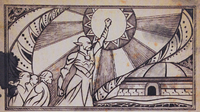
Following the Convention at the Adamantine Tower, where the gods set the laws of reality and cast out Lorkhan's Heart before departing from the affairs of Nirn,[27][32] the Aldmer organized into powerful arcane societies on the Summerset Isles. Much of their early history is lost or obscured, but it is known that many ruins and structures—most notably the Ceporah Tower—predate Aldmeri settlement by centuries.[5] During this period, the Aldmer likely warred with the Sload of Thras and other unknown beings for dominance over Summerset.[5][33] Eventually, they unified and constructed the Crystal Tower as a monument to their collective spirit and a pinnacle of magical achievement, unsurpassed until the rise of the Arcane University, which served as the headquarters of the Mages Guild founded by Vanus Galerion.[5][34] The Crystal Tower was considered their greatest architectural and metaphysical achievement, a monument to unity, arcane mastery, and the metaphysical Tower principle of Crystal-Like-Law.[34][5][34] It served as a beacon of Aldmeri civilization and the foundation of Altmeri identity.
Yet ideological schisms fractured Aldmeri unity. The most prominent of these was the Velothi dissident movement, which rejected Altmeri orthodoxy and led the Chimer eastward to what would become Morrowind.[35] Other groups, such as the Bosmer, Ayleids, and Orsimer, emerged independently in response to distinct cultural, spiritual, or metaphysical divergences—each embracing different interpretations of the divine.[36][37] Many traditions attribute the divergence of elven subraces to their differing relationships with the gods,[38][39][40][41][42] or to the realization that different Towers could tell different "stories" and thus shape different domains, leading to elven unity breaking due to different groups aligning themselves with alternative Towers and destinies.[32][UOL 2] The Maormer of Pyandonea were once considered a splinter group from Summerset, but tapestries in the Crystal Tower suggest their separation occurred before the Aldmer left Aldmeris. This view was accepted by both Altmer and Maormer sources by the Second Era.[43][44][45] The Altmer who remained in Summerset came to define themselves as the truest heirs of the Aldmer. Their society emphasizes purity of form, ancestral memory, and strict continuity of tradition. Songs are still composed in the Aldmeri language, and bloodlines are preserved through genealogical records and selective pairing.[46][40] Their arcane, political, and religious institutions all reflect a reverence for the past and a desire to emulate the perfection of their divine ancestors in hopes to one day rejoin them in the stars.[47][14]
First Era[edit]
Two prominent Altmeri institutions emerged during the First Era, shaping not only the Isles but also the wider development of Tamrielic civilization. The Psijic Order, based on the isle of Artaeum, became the foremost authority on mystical philosophy and arcane theory. Claiming descent from the oldest traditions of Aldmeri magic, the Order played a formative role in early conceptions of the metaphysical structure of the Aurbis and the practice of the Elder Way.[48][11] In contrast, the Direnni Clan embraced a more worldly approach. Originally one of the noble lineages of Summerset, the Direnni relocated to Balfiera in the Iliac Bay and gradually expanded their influence across High Rock. During the early to mid-First Era, they established a quasi-imperial dominion over large swaths of western Tamriel, including human populations.[49] Their rule culminated in the enforcement of the Direnni Hegemony, a legal and arcane regime that laid early groundwork for structured governance across the region.[50]
The Psijic Order and the Old Ways[edit]
The Psijic Order is the oldest known magical and philosophical organizations in Tamriel, predating even the establishment of the Mages Guild by many centuries. Its first known mention in recorded history dates to 1E 20, when the Breton sage Voernet chronicled his journey to the isle of Artaeum to confer with the Psijic Ritemaster, Iachesis.[11] However, the Order's true origins likely reach back to the earliest days of Aldmeri colonization of the Summerset Isles during the late Merethic Era.[51]
According to tradition, the Psijic Order was formed in response to a theological and social transformation among the early Aldmer. As Aldmeri society began to shift from the general veneration of all ancestors to the more hierarchical worship of ancestor-heroes—those claimed as divine progenitors by the ruling elites—the foundations of the Altmeri pantheon began to coalesce around the Aedra. In opposition, a faction of conservative Aldmeri mystics rejected this selective reverence, favoring the original, more universal worship of their ancestors.[51] These dissenters withdrew from mainstream society and settled on Artaeum, where they formalized their esoteric beliefs into what became known as the Elder Way.[52][11] The Elder Way, central to Psijic philosophy, emphasized introspection, meditation, and mastery of the self through magical discipline—especially through the school of Mysticism, which they viewed as a bridge between mortal perception and the divine architecture of the Aurbis. The Psijics taught that through disciplined spiritual and magical study, one could come to perceive and influence the hidden currents of reality.[48]
Though the Psijic Order generally discouraged direct intervention in worldly politics, it did not wholly isolate itself. The doctrine of seliffrnsae—“grave and faithful counsel”—governed their rare engagements with secular leaders.[48] The Psijics offered guidance only to those rulers they deemed wise or receptive to their teachings, often through cryptic visions, subtle manipulation of fate, or timely prophecy. The Ritemaster and the Council of Artaeum collectively oversaw such decisions, and their influence could be felt from the courts of the Altmeri kings to the battlemages of Cyrodiil.[48]
At the center of Psijic mysticism stood the legendary Ceporah Tower, which housed the Dreaming Cave—a site of immense arcane significance. This ancient structure allowed initiates to peer beyond the veil of Mundus, accessing the different planes of Oblivion or beyond.[53][54]
Although Artaeum and the Order itself would mysteriously vanish from the world for centuries at a time—most notably in the late Second Era—the Psijics' legacy endured in the institutions and magical philosophies they inspired, including the later formation of the Mages Guild by the Altmer Vanus Galerion, a former Psijic himself.[55]
The Direnni Hegemony[edit]
The Direnni (also known as Clan Direnni[56] and House Direnni)[57] are an aristocratic merchant clan of Altmer[nb 3] (formerly Aldmer)[27][58] whose members laid the foundation for modern alchemy, conjuration, and enchanting.[56][59][60] In stark contrast to the Psijic Order’s inward-looking mysticism, the Direnni Clan pursued a deliberate campaign of expansion and domination beyond the shores of Summerset. Descended from noble Altmeri lineages, the Direnni departed Alinor during the Middle Merethic Era and established their power base on the Isle of Balfiera, where they seized and repurposed the ancient Adamantine Tower. Revered as the oldest structure in Tamriel and the mythic site of the Convention, control of the Tower imbued the Direnni with both symbolic legitimacy and metaphysical authority, reinforcing their claim as rightful stewards of Merethic heritage.[49]
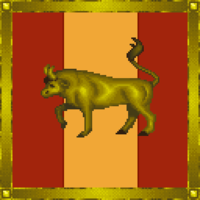
Over the following centuries, the Direnni hegemony stretched from all of High Rock, into large parts of Skyrim and Hammerfell constructing a formidable aristocracy upheld by magical dominance, bureaucratic centralization, and carefully orchestrated intermarriage.[61][62][60] The Direnni are known more for their legendary warriors and monarchs, and less for their spellcasters, but magic is still an important tradition to them.[49] The Direnni played a pivotal role in the ethnogenesis of the Bretons. During their dominion over High Rock, they engaged in widespread breeding with the subjugated Nedic population, who were often used as concubines or sexual slaves. This Aldmeri and Nedic interbreeding[6] occurred for centuries as far back as the Merethic Era.[58][63] The resulting mixed-race offspring, known as Manmer, formed a distinct racial group that gradually evolved into the Bretons over successive generations.[64][65] These individuals possessed partial Elven ancestry and a natural aptitude for magic. Although initially marginalized, the Bretons gradually rose in prominence within the Direnni administration and came to occupy more formalized roles, serving as retainers, scribes, battlemages, and even minor nobles within the Direnni courts. Over time, they developed a distinct cultural identity that synthesized Elven and human traditions.[64][65] The apogee of Direnni power came in 1E 482, when the battle-mage Aiden Direnni achieve an important victory over the Alessian Order at the Battle of Glenumbra Moors. This decisive triumph checked Alessian expansionism and secured Direnni dominance in High Rock. However, the momentum proved short-lived. By 1E 498, they were weakened after the war, and a combination of factors—including overextension, waning central authority, and the growing autonomy of Breton nobility—forced the Direnni to withdraw from the mainland, retreating to Balfiera.[66]
While no other Altmeri family would ever rival the Direnni in scope or longevity, smaller and unrelated efforts to establish mainland strongholds did occur. Among these, the Corelanya Clan is the most notable. In the sixth century of the First Era, the Corelanya settled the partially abandoned Ayleid city of Salas En in southern Hammerfell. There, they revitalized its ancient port and established maritime trade routes with Valenwood and the Topal Bay archipelagos. Unlike their orthodox cousins in Summerset, the Corelanya were known practitioners of Daedra-worship and were rumored to maintain covert ties with the seafaring Maormer, further alienating them from mainstream Altmeri society.[67] This southern enclave was ultimately destroyed in 1E 853 by Ra Gada forces under King Xakhwan, who launched a campaign to purge foreign settlements from the Hammerfell coast. The fate of any surviving Corelanya remains unknown; no historical record confirms their reintegration into Summerset society.[68]
Despite their retreat, the Direnni retained control of the Isle of Balfiera and demonstrated their continued martial strength by repelling a Yokudan naval assault during the Ra Gada invasion in 1E 907.[64] Nevertheless, by the Second Era, the clan had faded into a largely ceremonial role. What endured was their legacy: preserved in ancient texts, in the arcane traditions of their descendants, and in the enduring presence of the Adamantine Tower—silent and immutable, as the world changed around it.[69]
The Aldmeri Dominions and Imperial Rule[edit]
While mainland Tamriel experienced many problems and sagas during the First and early Second Era, the sea insulated the Altmer of Summerset from their problems, though they had their own limited internal conflicts as well as repeated, large-scale invasions from the Sload and Maormer to deal with.[5] In 2E 580,[70] however, amid the chaos of the Interregnum that followed the fall of the Second Empire, Queen Ayrenn of Summerset allied with the Bosmer of Valenwood and the Khajiit of Elsweyr in the Elden Accord to form the First Aldmeri Dominion.[71] The Dominion's propaganda decried the carelessness of Men and promoted the establishment of Elven rule across Tamriel, viewing the Aldmeri races as the only peoples with the "wisdom and restraint" to be its proper stewards. To that end, the Dominion fought the Three Banners War against the Daggerfall Covenant and Ebonheart Pact for control of mainland Tamriel.[72] The war's ultimate outcome is unknown, but all three alliances, as well as the Empire of Cyrodiil, had ceased to exist by the ninth century of the Second Era.
A Second Dominion was established in 2E 830 following Altmer intervention in a dynastic dispute in Valenwood. The Second Dominion once again allied the Altmer with the Bosmer and Khajiit, but also with the Maormer — their hereditary enemies, who claim that the Altmer are a mongrel race and that the Sea Elves (Maormer) are the true descendants of the “purest strain” of Aldmeri ancestors, though this claim is highly dubious.[44][59] This expanded alliance could not stand against Tiber Septim, who crushed the Dominion with the help of the Numidium and finally brought the Summerset Isle into the Imperial fold in 2E 896.[73][74] The Altmer remembered the conquest with shame and horror, and likely contributed to social unrest among their youth later in the Third Era.[5] The Maormer, for their part, resumed hostilities in the 3E 110, attacking and threatening to conquer Summerset in the War of the Isle. The Altmer, already under the Empire, had to accept the assistance from the Septim Third Empire in order to repel the invasion.[5] The united alliance of the kings of Summerset and Antiochus Septim,[74] combining the Imperial fleet and the royal navies of Summerset Isle, together with the magical powers of the Psijic Order, succeeded in destroying the Pyandonean invading fleet.[75]
The Fourth Era[edit]
The Oblivion Crisis of 3E 433 proved an even more traumatic moment for the Altmer. As Daedra overran Tamriel, the unnatural turmoil of the seas killed many of the Altmer fleeing the mainland to Summerset, and wrecked the ports that would have received them. The Crystal Tower briefly served as a stronghold for the surviving refugees in Summerset until it fell to powerful Daedric forces.[76] A group named the Thalmor, originally an obscure bureau for the preservation of Altmeri heritage, had played an important role in the governments of the First and Second Dominions.[77][59] Following the chaos of the Crisis, an extremist cabal of Altmer supremacists now assumed this name and claimed credit for saving the Altmer from extinction using "deep and subtle magicks".[78] In 4E 22, the re-formed Thalmor seized power in Summerset outright and deposed the Altmer monarch, renaming the province Alinor.[79][80] Soon afterwards, in 4E 29, a faction friendly to the Thalmor took over Valenwood and formed a new union with the Altmer, establishing the Third Aldmeri Dominion.[79]
The Third Dominion proceeded to break off all contact with the Empire, and the Altmer lands remained silent to the outside world for some seventy years as the Thalmor consolidated their power.[79] A grim demonstration of the ruthlessness of the Thalmor in this pursuit – and the continuing resistance to their rule among some Altmer – was the Night of Green Fire in 4E 42, in which a group of Altmer dissidents were massacred by Thalmor mages at Sentinel.[81] At any rate, the Thalmor's sway continued to expand. After Nirn's moons vanished in the Void Nights of 4E 98–100, they claimed credit for their restoration and persuaded the Khajiit of Elsweyr to ally once more with the Aldmeri Dominion in 4E 115. Finally, the Thalmor turned their sights on the Empire itself. From 4E 171 to 175 the Dominion fought the Great War against the Empire, inflicting a series of punishing defeats that led to the signing of the White-Gold Concordat, which ceded large parts of southern Hammerfell to the Dominion, disbanded the Blades, and banned the worship of the man-god Talos across the Empire.[79]
With the entire province of Hammerfell having gained independence from the Empire, and the Empire itself in turmoil from a civil war in Skyrim – abetted by the Thalmor and the possible assassination of Emperor Titus Mede II[82][83] – the Altmer had attained a position of substantial power in Tamriel by 4E 201, though much remained unclear about the situation in Alinor itself.
The apprentice of Balagog gro-Nolob, Urzhag gro-Larak, visited the Summerset Isles several times around the end of the Second Century of the Fourth Era during his travels across Tamriel which saw him learn from a variety of races to improve his cooking skills. During one of these visits, he got permission with two other foreign chefs to research under some limitations in the College of Sapiarchs. Though the Isles were opened up, many of the native inhabitants were still hesitant to outsiders.[84]
Religion and Cosmology[edit]
The religious worldview of the Altmer is deeply rooted in their belief that they are the direct descendants of the Aedra, or "ancestor spirits"—divine beings who gave their essence to shape the mortal world.[3][4] According to Altmeri myth, the cosmos began before the Dawn Era, when the primordial force Anu, representing stasis and order, brought forth Anuiel, the soul of all things. Anuiel then created Sithis, the personification of change and limitation, so that it might know itself.[85] The interplay of Anuiel and Sithis gave rise to the Aurbis, the chaotic void in which the Original Spirits-that would come to be known as Aedra and Daedra—emerged.[3]
The Altmer interpret the creation of the Mundus as a cosmic catastrophe initiated by Lorkhan, the "Trickster God," who persuaded some spirits to participate in creating a flawed, mortal plane. This act is seen as a spiritual fall from the divine to the temporal, severing the Elves from their ancestral eternity.[86] The emergence of the elves is described in the Altmeri creation myth, according to which some of the Aedra that stayed to work on Nirn after Magnus departed, known also as the Ehlnofey,[UOL 1][28] chose to have offspring. The ensuing offspring grew progressively weaker than their parents with each generation, a phenomenon of generational diminishment that soon led to the emergence of the first Aldmer.[3] Auri-El, the chief deity of the Altmeri pantheon and the soul of Anuiel, from whom most modern Altmer claim direct descent, is said to have opposed Lorkhan, led the faithful Aedra against him, and eventually ascended to Aetherius, becoming a model of apotheosis for his followers.[86][47]
Over time, social stratification influenced religious practice. The lower classes increasingly adopted the ancestor spirits claimed by their social superiors over their own, contributing to the consolidation of a more centralized pantheon, comprised of figures such as Auri-El, Trinimac, Syrabane, and Phynaster, who were among those ancestor spirits that came to be considered gods. A shift in religion opposed by some of the Aldmeri elders, who broke off to form the Psijic Order in protest.[5] Despite this convergence, debates persist over which beings are truly worthy of veneration, and dissenters—especially those sympathetic to Men or heterodox figures like Lorkhan—are often marginalized or persecuted.[79] Altmer view themselves as "true children of the Et'Ada", descendants of the Aedric Divines in an unbroken line dating back to Nirn's creation, a divine lineage which is thought to allow them to achieve Apotheosis in certain circumstances.[87][88][26] The ultimate spiritual aspiration of the Altmer is thus to transcend mortality and return to the divine state of their ancestors, following the example of Auri-El and the Aedra. In this, their religion serves not only as a cultural anchor but as a metaphysical roadmap back to the stars.[47]
The principal Altmeri pantheon consists of Auri-El, Magnus, Trinimac, Y’ffre (also called Jephre), Xarxes, Mara, Stendarr, and Syrabane.[24] Additional cults also revere deities such as Phynaster and, controversially, Lorkhan.[24] However, limitations to eight or nine deities are considered an Imperial imposition and are generally rejected by traditionalist Altmer.[5] Sacred numbers in Altmeri numerology include three, five, and eight, each reflecting metaphysical ideals of harmony and balance.[89] The Altmer view their gods as parts of a "divine body", often articulated in religious teachings as follows: the Hand of Auri-El, Eye of Magnus, Arm of Trinimac, Bones of Y’ffre, Mouth of Xarxes, and Heart of Mara. Altmer theology holds that through devotion, they remain spiritually united with these divine aspects.[90] Among these deities, Xarxes holds particular importance as the god of memory, record-keeping, and genealogy. Believed to have been either Auri-El’s divine scribe since the beginning of time, or a mortal priest who ascended to divinity, he now maintains an eternal archive of every Altmer life.[26][91] He is also credited with authoring the Aldmeriad, the Elven origin epic, and instructing the Altmer to create Oghmas—everscriven scrolls that memorialize their lives as sacred duty in honor of their inherited divine spark.[87]
Altmeri religious authority is governed by a priestly hierarchy. Aldarchs lead monastic communities dedicated to peace and meditation,[92] while temple priests instruct acolytes and officiate public rites.[90] Ascendant Curates manage the conferral, refinement, and ceremonial destruction of calians—talismanic tokens bestowed upon young Altmer at the age of majority, signifying their entrance into adult society.[93][94]
Stendarr is a controversial figure in Altmeri religion. Some venerate him for his compassion and burden-bearing, while others denounce him as a god of Men, unworthy of worship.[95][96] The popular hymn Praise Be originally included a verse extolling Stendarr, which was omitted in later written versions—suggesting a rift in doctrinal acceptance.[97] Daedra worship is officially outlawed and culturally taboo, though some Altmer—particularly those drawn to power and arcane mastery—form clandestine cults to the Daedric Princes.[98][99] Civil authorities prosecute these practices harshly, and the living gods of the Tribunal Temple are viewed as seditious heresies.[100] Some Altmer are venerated posthumously as saints, such as Saint Ohmandil and Saint Terilde. Their relics, including the Circlet of Saint Ohmandil and Saint Terilde's Fingerbone, are preserved and honored in temples and monasteries.[101][102][103]
With the coming of the Third Empire, many Altmer resented the apotheosis of Talos, bitterly recalling Tiber Septim’s brutal conquest of the Summerset Isles.[80] However, large-scale religious controversy did not erupt until the Thalmor seized power in the early Fourth Era. The Thalmor declared that no human like Tiber Septim, could achieve godhood,[104] and outlawed the worship of Talos within their territories.[80] In the lead-up to the Great War, the ban on Talos worship was formalized as one of the Aldmeri Dominion’s demands to the Empire—demands largely seen as a pretext for an invasion that was already planned.[105] Emperor Titus Mede II conceded to the ban in the White-Gold Concordat, a peace treaty that ended the conflict.[106] Afterward, incidents such as the Markarth Incident saw the Thalmor demand the right to enforce the ban on Talos worship within Imperial territory, claiming the authority to uphold the treaty—despite using it to justify further espionage and suppression in preparation for renewed conflict.[107][108]
Culture[edit]
Social Structure and Hierarchy[edit]
At the time the Crystal Tower was built in the Merethic Era, the Elves of Summerset had a relatively egalitarian society, though social stratification slowly developed into a rigid hierarchy of classes over the millennia.[5] The Wise (teachers and priests) became the highest echelon, followed by Artists, Princes, Warriors, Landowners, Merchants, Workers, and enslaved peoples such as Goblins.[5] Early literature by man painted the High Elves in poor light, though the impartiality of these accounts is questionable. It was suggested that the Altmer practiced eugenic infanticide, putting to death nine in ten of their newborns due to impurities, that Altmeri names are simply combinations of numbers in their own language, and that Altmer culture revolves around displaying social status.[59] Some of this has basis in fact; Altmer born with deformities or impurities are often – though not always[UOL 3] – abandoned by their parents as "hulkynd" (sometimes to be raised by priests of Stendarr),[109] and the full name of an Altmer is relatively extensive, detailing their patrilineal and matrilineal histories in addition to the history of their clan.[16]
Praxis[edit]
At an Altmer's coming of age, they are granted a calian, a sphere of aetherquartz crystal representing their honor and social status.[15][110] The aetherquartz in calian spheres is polished using ground pumice and ocean sand.[111] Calians are considered to be "praxic talismans".[112] Mer who have committed some particularly grievous crime against Altmer law are termed "ousters" and "apraxics". While ousters are simply banished from their homes,[113] apraxics are treated more severely: their calians are ceremonially shattered by a curate and it is wholly forbidden for Altmer in good standing to speak to them.[114][112] Some apraxics labor for years to restore their status, as part of which they must painstakingly repair their own calian,[15][115] while others choose to remain in exile. Nonetheless, in the middle of the Second Era subversive literature written by aprax mer gained wide currency among young Altmer on Summerset Isle,[114] and provoked some of them to engage in revolutionary activity.[112] This questioning of Altmer customs coincided with reforms introduced by Queen Ayrenn after the founding of the First Aldmeri Dominion, including the end of Summerset's longstanding isolation and the opening of its borders to other races and cultures, which provoked heated debate and political maneuvering.[116][117][118]
Alaxon[edit]
One of the dominant philosophies of the Altmer of Summerset is the "Path to Alaxon". Alaxon is the state of perfection that every High Elf strives for. The Path to Alaxon represents the approach Altmer take to achieve that state. Practice of the Path requires intense dedication and concentrated effort.[14] Those who are judged to have attained a degree of perfection are granted an alaxon sphere, which, like calians, may be destroyed if they are judged to have fallen from it.[119] The Path to Alaxon is reflected in Summerset's characteristic architecture, which builds on the aesthetic practice of past architects in a sequential process of refinement.[UOL 4]
Law and Government[edit]
Altmer society was highly stratified by the middle of the Second Era. The monarch of Summerset ruled as sovereign with the advice of the College of Sapiarchs, an elite and highly selective scholarly institute,[17] and was sometimes represented by a viceroy titled the Proxy Queen or King.[120] The monarch descended from an almost continuous line of royalty extending back to the Merethic Era.[121] Their behavior was regulated by a set of written precedents known as the Scrolls of Praxis, whose chief interpreters were the Sapiarchs: these formed part of a broader system of inherited norms termed the Ceremoniarchy.[18][70] The heir to the throne was required to study the Ceremoniarchy for 3,555 days in the Sapiarchs' Labyrinth before they could take the crown,[17] and royal decrees were issued in its name.[116] Hereditary nobles termed kinlords and kinladies held many of the Altmer lands in fief. Altmer royalty were assisted by lieutenants titled vicereeves,[122] while cities that served as county seats were administered by canonreeves, civil officials equivalent to mayors in other cultures.[123]
The Divine Prosecution administers secular and religious justice,[124] and is made up of jurisreeves overseeing investigations and rank-and-file justiciars. Jurisreeves travel and deliberate in groups of three, each with distinct responsibilities: a revelator-naganwe to conduct magical inquiries, an admanen to serve as an inspector, and a thalmilan who would weigh the evidence and render a verdict.[125] The jurisreeves may have originated as a religious order.[126] Under Queen Ayrenn's First Aldmeri Dominion, executive responsibilities were increasingly assumed by the Thalmor, originally a bureau for the protection of Altmeri heritage.[77] The Thalmor incorporated the Divine Prosecution as a division at that time,[127] but the Prosecution existed long before the Thalmor's rise to power.[128]
The Altmer stringently regulate traffic into Summerset, and they have banned the import of such foreign goods as books, foods and perfumes in the past.[129] At the time of the First Aldmeri Dominion, the roster of forbidden books included mundane foreign writings judged to be "coarse", but the Divine Prosecution devoted particular attention to the suppression of literature promoting Daedra worship.[130]
Altmer politics was transformed in the early Fourth Era by the return of the Thalmor as a militant Elven supremacist group following the Oblivion Crisis. In the wake of the chaos caused by the Crisis and the fall of the Crystal Tower, the Thalmor overthrew the Summerset monarchy in a coup d'état.[80] Since then, officers of the Thalmor have taken direct charge of government functions such as diplomacy and espionage.[131]
Dissidence and Reform[edit]
As mentioned, whenever a substantial minority had some sort of socio-political or theological disagreement with the majority in Summerset in the Dawn Era, the dissidents would leave and usually go on to become other races of Mer. However, some time in the Merethic Era, one early group of dissidents who opposed the evolution to the traditional Altmer pantheon left the mainland of Summerset but remained quintessentially Altmer. The Psijics decided to follow the mystical Old Ways of Aldmeris and broke away to settle Artaeum, the third-largest island of the Isle.[5][74][11] Though they have often refused requests for dialogue from Alinor during their periods of seclusion from Tamriel,[132] the Psijics are not hostile to the other Altmer, and have offered their magic to protect Summerset in the past.[133] A leader of the Psijics, Ritemaster Iachesis, led them through the entire First Era and most of the Second, a span of some 3,500 years, giving some indication of the potential longevity of the Altmer.[11][134][135]
A subsequent bout of dissent occurred late in the Third Era, as younger Altmer again began pushing for social reform. These episodes were unusual in a society used to dissidents simply leaving.[5] But there were few if any places left to go at that point. Some change had taken place by the end of the Third Era: the Altmer once more allowed foreigners to come to their shores; some non-Altmer were even allowed to rise to the ranks of nobility in Summerset.[5] Many of these young rebellious Altmer turned to the Psijics for guidance, somewhat ironically consulting their distant past for a path to their future, while some militant radicals turned to terrorism.[5]
These tentative reforms were substantially reversed at the turn of the Fourth Era by the rise of the Thalmor, who instituted a policy of persecution and even open slaughter of dissidents and non-Elven races.[80] Numerous surviving Altmer dissidents were forced to flee to other parts of Tamriel, where they were frequently targeted by Thalmor assassins.[81][80] While many Altmer continue to disagree with the Thalmor in private, few venture to oppose them publicly.[136]
Fashion[edit]
Silk is a common material in Altmeri fashion. Canonreeves might be seen carrying silken parasols to guard from the sun's rays[137] and lace trimmed silk handkerchiefs on their person.[138] Neckerchiefs are also worn.[139] Some parasols bear minor enchantments allowing them to magically protect the area beneath and around the user from the weather.[140]
A kinlord may use fine beeswax to polish his boots.[141] Altmer in general often wear their boots overly tight so they can purposefully show off their ankles and so tend to have to use silver shoehorns to remove them.[142] A Kinlady wearing the styles of Skywatch or Firsthold may wear riding boots sporting diamond tipped silver spurs.[143] Should a high elven lady wish to swim in Summerset's pristine waters she may wear nothing more than a sensuous thong bathing suit gleaming with silver sequins.[144]
Holidays[edit]
- Day of the Divine Reverence
- It is a several day celebration held by the Sapiarchs. Their 58th day is dedicated to Mara and the Rose-of-Archon, grown only in the forest of Archon's Grove, is vital in their ceremony.[130]
- Festival of Defiance
- An annual celebration dedicated to freedom and victory. It is in remembrance to the day when the Altmer of Skywatch retook their city from the Sload, with help from the All Flags Navy.[145][146]
- New Life Festival
- Like the other races of Tamriel, the Altmer celebrate the New Life Festival which celebrates the birth of a new year and the death of the old year.[147][84]
Artifacts[edit]
Flask of Lillandril[edit]
The Flask of Lillandril is a magical flask that absorbs and reflects magic of all kinds. Its anti-magic property also prevents mages from detecting its location. The flask was discovered around the year 1E 470 by a group of elves living in the Summerset Isle city of Lillandril. The elves spread news of their discovery, enough to make it an artifact of song and legend. It became the city's symbol and was displayed on their banners.
The elves used the flask to perform favors for the barons of Summerset Isle by keeping in check the magical power of the Bosmer in Valenwood. One legend says that a stable boy defeated the High Wizard of Valenwood using only the flask. After some time, the elves who discovered the flask feared that Bosmer assassins would kill them, so they fled for Daggerfall, hoping to buy safety from the Direnni. The elves shipwrecked off the southern coast of Stros M'Kai, killing all of them according to legend, and the Flask of Lillandril was lost.
Heart of Transparent Law[edit]
The Heart of Transparent Law is a part of the Stone of the Crystal Tower, Transparent Law. The Heart was taken from the Tower shortly after the founding of the Mages Guild in 2E 230 by Ritemaster Iachesis of the Psijic Order, who was under the control of K'Tora of the Abyssal Cabal through the use of mind magic. In a desperate attempt to keep the Sea Sloads from using the Heart to sink Summerset, Iachesis enlisted the help of Nocturnal to hide the Heart inside his own body. During the Interregnum, Nocturnal tried to take control of the Crystal Tower. Using a technique she stole from Sotha Sil utilizing life energy as a power source, she planned to use the life energy of Nirn, and then the energy of the other Princes afterwards, to amplify the Crystal Tower to make her power limitless. Nocturnal's plan was foiled by the Psijic Order and the Vestige, with the assistance of Mephala and Clavicus Vile, who had been betrayed by Nocturnal, and the Golden Knight, who was the vessel of Meridia. Using the divine power of Meridia's Dawnbreaker, the Vestige defeated Nocturnal and restored Transparent Law using the Heart. The Heart of Transparent Law was said to awaken a dark urge to seize it for themselves in those who looked upon it.
Obscuros[edit]
The Obscuros is a scrying artifact that enhances the user's Sight and projects their visions in the form of holographic constructs for anyone to see. It is said to be the most powerful scrying device on Tamriel. It was used and protected by the ancient Psijics before being deactivated and hidden to prevent its misuse, being relocated to the island of Dranil Kir and locked away with magical traps. The artifacts' presence on the island made it infamously plagued by severe weather.
Ring of Phynaster[edit]
The Ring of Phynaster is an artifact created by the eponymous Hero-God of the Altmer. The Ring improves its wearer's overall resistance to poison, magicka, and shock. The ring added much needed security for Phynaster to survive his adventurous lifestyle. Because of this, he lived for hundreds of years, and it has since been passed from person to person. The ring has become synonymous with Phynaster, so much so that it will not stay with anyone, other than the Hero-God himself. When it is kept long enough, it will disappear to another resting place, for the next adventurer.
Unraveling Staff[edit]
The Unraveling Staff, occasionally called a wand, is a powerful staff artifact renowned for its ability to unravel any material. It was crafted in Summerset by Anillyon. It is extremely dangerous, capable of dismantling buildings, trees, and even flesh of living beings.
Gallery[edit]
Appearances[edit]
Miscellaneous[edit]
A Third Era Altmer
(Morrowind)
Notes[edit]
- The term "High Elf" originates in the works of J. R. R. Tolkien's legendarium.
See Also[edit]
- Altmer Names
- For a list of notable Altmer, see here.
- For game-specific information, see the Arena, Daggerfall, Battlespire, Morrowind, Shadowkey, Oblivion, Skyrim, Elder Scrolls Online, Legends, and Blades articles. Also see the Redguard category.
- High Elvish
Books[edit]
- A Case for Open Borders by Kinlord Andurion — A father's plea for his fellow Mer to open their minds
- Civility and Etiquette by Coristir — An Altmer guidebook outlining the correct social protocols when dealing with various peoples and beings
- Crafting Motif 1: High Elf Style by Doctor Alfidia Lupus — Beginning notes by Doctor Alfidia Lupus for a series of pamphlets on the major cultural styles of Tamriel
- The Great War by Legate Justianus Quintius — A soldier's summation of the major events before and during the Great War
- Guide to Altmeri Culture — An excerpt on Altmer dueling traditions
- Notes on Elven Architecture by Gastinus Florus, Masons' Guild Historian — Notes on Altmer architecture and its similarities to Ayleid design
- On the College of Sapiarchs by Adandora, Chronicler at Large — A treatise on the renowned College of Sapiarchs in Summerset
- The Price of Praxis by Ceruval Rolumaril — An Altmer recounts his life and the importance of his calian
- Protocol and Propriety in Summerset — A note outlining proper etiquette when dining with Altmer
- A Rejection of Open Borders by Kinlady Avinisse of Shimmerene — A member of the Summerset nobility explains her opposition to the Queen's Decree
- Rising Threat by Lathenil of Sunhold — A multi-volume series on the threat posed by the Thalmor
- Sages of the Crystal Tower by Nularan, Mages Guild Scribe — A Mages Guild scholar describes the renowned Sapiarchs of the Crystal Tower
References[edit]
- ^ Pocket Guide to the Empire, 1st Edition: Prologue — Imperial Geographical Society, 2E 864
- ^ The Wild Elves — Kiergo Chorvak
- ^ a b c d e f g h The Monomyth
- ^ a b Aedra and Daedra
- ^ a b c d e f g h i j k l m n o p q r s t u v Pocket Guide to the Empire, 3rd Edition: The Blessed Isle: Alinor and the Summersets — Imperial Geographical Society, 3E 432
- ^ a b c Pocket Guide to the Empire, 3rd Edition: All the Eras of Man, A Comprehensive History of our History — Imperial Geographical Society, 3E 432
- ^ Race Description of Altmer in Legends
- ^ High Elf in-game description in Oblivion and Skyrim
- ^ Ask Us Anything: Variety Pack 4
- ^ a b The Real Barenziah, v 2 — Anonymous
- ^ a b c d e f Fragment: On Artaeum — Taurce il-Anselma, 3E 400
- ^ Psijic Mascot Bear Cub pet description in ESO
- ^ High Elf racial abilities in Daggerfall
- ^ a b c Olnewil's dialogue in ESO: Summerset
- ^ a b c The Price of Praxis — Ceruval Rolumaril
- ^ a b Lirendel's Family Shrine
- ^ a b c On the College of Sapiarchs — Adandora, Chronicler at Large
- ^ a b Sages of the Crystal Tower — Nularan, Mages Guild Scribe
- ^ Notes on Elven Architecture — Gastinus Florus, Masons' Guild Historian
- ^ Antecedants of Dwemer Law
- ^ High Elf in-game description in Daggerfall
- ^ a b Pocket Guide to the Empire, 1st Edition: Aldmeri Dominion — Imperial Geographical Society, 2E 864
- ^ a b c High Elf character creation options in ESO
- ^ a b c Varieties of Faith: The High Elves — Brother Mikhael Karkuxor of the Imperial College
- ^ Crafting Motif 11: Ancient Elf Style — Seif-ij Hidja
- ^ a b c Tu'whacca, Arkay, Xarxes — Lady Cinnabar of Taneth
- ^ a b c d Before the Ages of Man — Aicantar of Shimerene
- ^ a b The Mystery of Artaeum — Penewen, Advisor to the Court
- ^ a b The Annotated Anuad
- ^ Monomyth Reforged antiquity codex entries in ESO
- ^ French translation of The Monomyth
- ^ a b Aurbic Enigma 4: The Elden Tree — Beredalmo the Signifier
- ^ Pocket Guide to the Empire, 3rd Edition: Other Lands — Imperial Geographical Society, 3E 432
- ^ a b c The Crystal of the Tower — Larnatille of Lillandril, Sapiarch of Arcanology
- ^ A Short History of Morrowind — Jeanette Sitte
- ^ The Changed Ones
- ^ Pocket Guide to the Empire, 3rd Edition: The Throat of the World: Skyrim — Imperial Geographical Society, 3E 432
- ^ The True Nature of Orcs
- ^ The Anticipations — Anonymous
- ^ a b Vivec and Mephala
- ^ Father Of The Niben — Florin Jaliil
- ^ The House of Troubles
- ^ The Maormer of Pyandonea — Imperial Geographical Society
- ^ a b The Chosen People of Aldmeris — Sealord Malleroth Of Pyandonea
- ^ The False Revanchism of the Maormer — Hadendril of Skywatch
- ^ High Elf Songbook contraband description in ESO
- ^ a b c Vairabrian's dialogue in ESO
- ^ a b c d The Old Ways — Celarus the Loremaster
- ^ a b c De Rerum Dirennis — Vorian Direnni
- ^ Before the Ages of Man — Aicantar of Shimerene
- ^ a b Pocket Guide to the Empire, 3rd Edition: The Blessed Isle: Alinor and the Summersets — Imperial Geographical Society, 3E 432
- ^ Mysticism — Tetronius Lor
- ^ Ritemaster Iachesis' dialogue in ESO: Summerset
- ^ 2920, The Last Year of the First Era — Carlovac Townway
- ^ Origin of the Mages Guild — The Archmage Salarth
- ^ a b The Bretons: Mongrels or Paragons? — Phrastus of Elinhir
- ^ Systres History: Volume 1 — Trilam Heladren, Associate Dean of Eltheric History, University of Gwylim
- ^ a b Modern Day Bretons: Man or Mer? — Vastyr Historian Filibert Beauchamp
- ^ a b c d Pocket Guide to the Empire, 1st Edition: Aldmeri Dominion — Imperial Geographical Society, 2E 864
- ^ a b Once — Beredalmo the Signifier
- ^ A Life of Strife and Struggle — King Laloriaran Dynar
- ^ The Daggerfall Chronicles — Ronald Wartow
- ^ Loremaster's Archive - Tamriel's Dungeons — Dhulef
- ^ a b c The Bretons: Mongrels or Paragons? — Phrastus of Elinhir
- ^ a b Pocket Guide to the Empire, 1st Edition: High Rock — Imperial Geographical Society, 2E 864
- ^ The Last King of the Ayleids — Herminia Cinna
- ^ The Salas En Expedition — Lady Clarisse Laurent
- ^ Prince Haqmir's dialogue in ESO
- ^ Lauriel's Lament quest in ESO
- ^ a b Ayrenn: The Unforeseen Queen — Headmaster Tanion of the College of Aldmeri Propriety
- ^ Queen Ayrenn's dialogue in ESO
- ^ Welcome to New Aldmeri Irregulars — Aicantar of Shimmerene, Sapiarch of Indoctrination
- ^ On Morrowind — Erramanwe of Sunhold
- ^ a b c Brief History of the Empire v 1 — Stronach k'Thojj III
- ^ The Wolf Queen, v5 — Waughin Jarth
- ^ Rising Threat, Vol. I — Lathenil of Sunhold
- ^ a b Aicantar of Shimmerene Answers Your Questions — Aicantar of Shimmerene
- ^ Rising Threat, Vol. II — Lathenil of Sunhold
- ^ a b c d e The Great War — Legate Justianus Quintius
- ^ a b c d e f Rising Threat, Vol. IV — Lathenil of Sunhold
- ^ a b Legate Fasendil's dialogue in Skyrim
- ^ Thalmor Dossier: Ulfric Stormcloak
- ^ Events of To Kill an Empire in Skyrim
- ^ a b The Elder Scrolls: The Official Cookbook Vol. 2 — Erin Kwong, Victoria Rosenthal
- ^ Sithis
- ^ a b Varieties of Faith... — Brother Mikhael Karkuxor of the Imperial College
- ^ a b The Onus of the Oghma — Phrastus of Elinhir
- ^ Ayrenn: The Unforeseen Queen — Headmaster Tanion of the College of Aldmeri Propriety
- ^ Thoughts on the Sacred Numbers
- ^ a b Uurkar of Auri-El's dialogue in ESO
- ^ Words and Power — Telenger the Artificer
- ^ Monastic Firinore's dialogue in ESO
- ^ The Price of Praxis — Ceruval Rolumaril
- ^ Aetherquartz Prayer Beads codex entry in ESO
- ^ Rituals of the Harmonious Masters — Aritanwe of Lillandril
- ^ Transcription of Praise Be
- ^ Praise Be
- ^ Dialogue from ON:Seeker Duperil and ON:Seeker Veraye in ESO
- ^ The Banished Cells loading screen in ESO
- ^ ON:Sotha Sil's dialogue in ESO
- ^ Circlet of Saint Ohmandil item description in Online:ESO
- ^ Saint Terilde's Fingerbone item description in Online:ESO
- ^ Monastic Nenaron's dialogue in Online:ESO
- ^ Ondolemar's dialogue in Skyrim
- ^ Events of Skyrim:Diplomatic Immunity in Skyrim
- ^ Dialogue and documents in White-Gold Concordat
- ^ Events of Markarth Incident
- ^ Dialogue and Thalmor dossiers in Skyrim
- ^ Manacar's dialogue in ESO
- ^ Aquiline Calian Sphere codex entry in ESO
- ^ Aetherquartz Prayer Beads codex entries in ESO
- ^ a b c Dialogue of the Mother of Rats in ESO: Summerset
- ^ Azarari's dialogue in ESO
- ^ a b Lanarie's dialogue in ESO: Summerset
- ^ Apraxic Decanter codex entries in ESO
- ^ a b An End to Isolation — Queen Ayrenn
- ^ A Case for Open Borders — Kinlord Andurion
- ^ A Rejection of Open Borders — Kinlady Avinisse of Shimmerene
- ^ Cases of the Divine Prosecution — High Magistrate Rinwaray, Bureaureeve of the Divine Prosecution
- ^ Valsirenn's dialogue in ESO: Summerset
- ^ Alinor Royal Palace loading screen in ESO: Summerset
- ^ Vicereeve Pelidil's dialogue in ESO
- ^ Canonreeve Elquisa's dialogue in ESO: Summerset
- ^ The Divine Prosecution — Axulfa Giant-Slayer, Nord Cultural Exchange
- ^ Jurisreeve Lorne's dialogue in ESO: Summerset
- ^ Jurisreeve's Eye codex entries in ESO
- ^ Chief Justiciar Carawen's dialogue in ESO: Summerset
- ^ Please Respond, Your Beloved Aunt Daiyanni — Kinlady Daiyanni
- ^ Renzir's dialogue in ESO: Summerset
- ^ a b Justiciar Tanorian's dialogue in ESO: Summerset
- ^ Events of Diplomatic Immunity in Skyrim
- ^ The Mystery of Artaeum — Penewen, Advisor to the Court
- ^ Events of The Tower Sentinels in ESO: Summerset
- ^ 2920, The Last Year of the First Era — Carlovac Townway
- ^ Events of Lost in Translation in ESO: Summerset
- ^ Telarendil's dialogue in Blades
- ^ Canonreeve's Silken Parasol item description in ESO
- ^ Canonreeve's Silken Handkerchiefs item description in ESO
- ^ Summerset Silk Neckerchief item description in ESO
- ^ Clement Climate Picnic Parasol item description in ESO
- ^ Archon's Hive Boot Polish item description in ESO
- ^ Silver Shoehorn item description in ESO
- ^ High Kinlady's Diamond-Tipped Spurs item description in ESO
- ^ Swan-Satin Bathing Thong item description in ESO
- ^ Guide Culast's dialogue in ESO
- ^ Captain Tendil's dialogue in ESO
- ^ Spread Holiday Cheer During The New Life Festival
Note: The following references are considered to be unofficial sources. They are included to round off this article and may not be authoritative or conclusive.
- ^ a b Michael Kirkbride's Posts
- ^ a b Nu-Mantia Intercept — Nu-Hatta, The Imperial Library
- ^ Leamon Tuttle's Posts - 12/29/20
- ^ ESO Live Summerset Story and Lore
| |||||||||||||||||||||||||||||||||||||||||||
